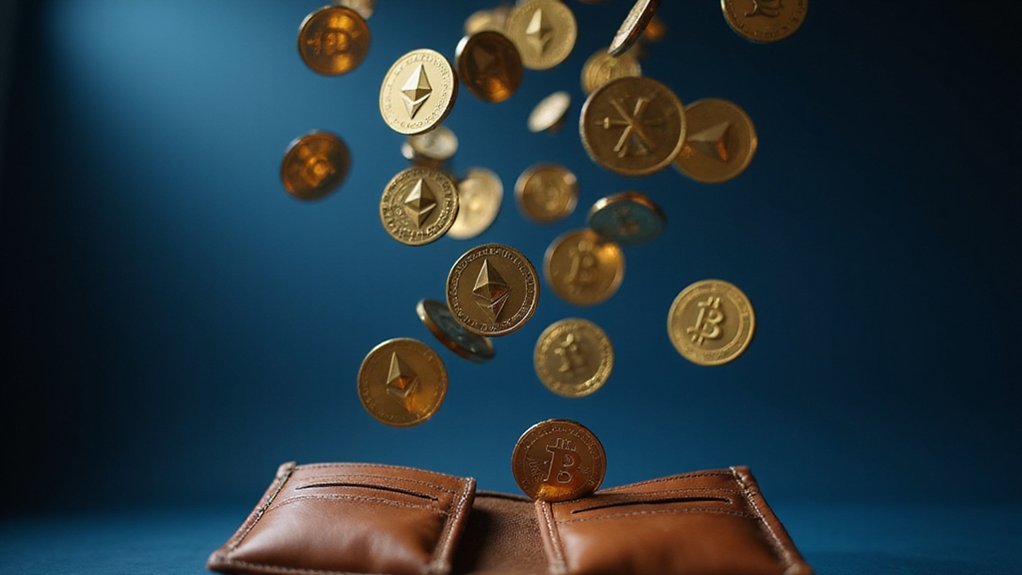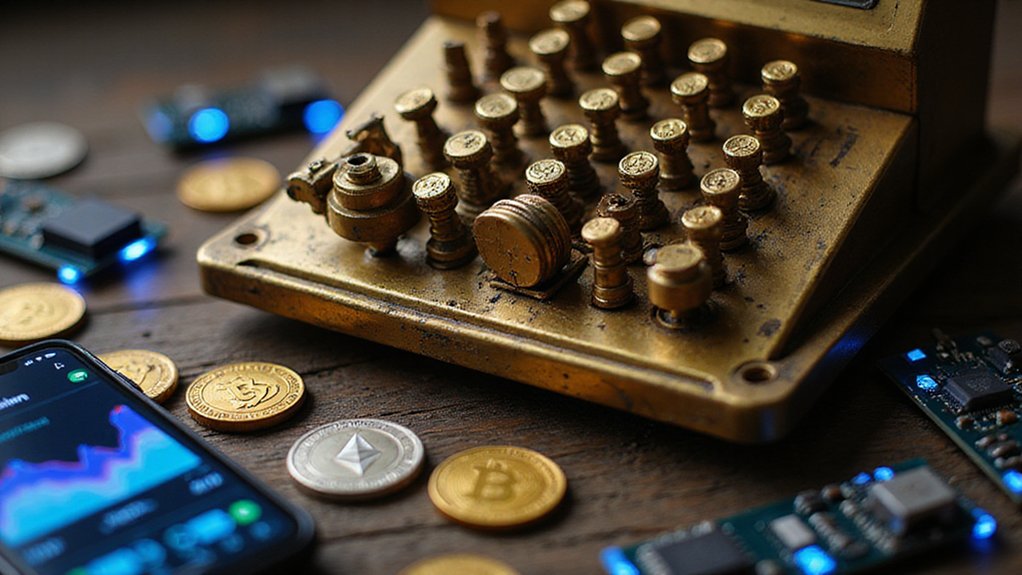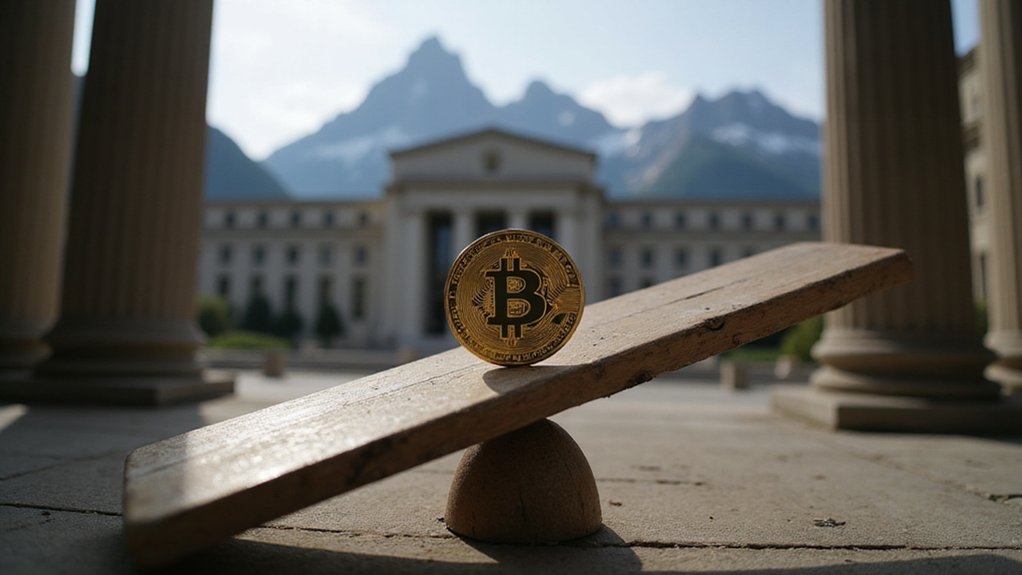Decentralized Finance (DeFi) eliminates traditional banks and brokers through blockchain-based smart contracts that facilitate lending, borrowing, and trading without intermediaries. Built primarily on Ethereum, these protocols offer complete accessibility and transparency while processing transactions faster than conventional systems. However, smart contract vulnerabilities and cryptocurrency volatility create substantial risks that can permanently destroy funds—a sobering reality for users accustomed to FDIC insurance and customer service departments. The regulatory landscape remains murky, with oversight bodies struggling to address this pseudonymous financial ecosystem that operates in legal gray areas, leaving early adopters to navigate between potential financial liberation and sophisticated wealth redistribution schemes.

What happens when an entire financial system decides to eliminate the very institutions that have dominated money management for centuries? The answer emerges in decentralized finance (DeFi), a peer-to-peer financial ecosystem built on blockchain technology that systematically removes banks, payment processors, and other traditional intermediaries from monetary transactions. This isn’t merely technological innovation—it’s financial revolution disguised as software engineering.
DeFi operates primarily on public blockchains, particularly Ethereum, where decentralized applications (dApps) execute financial services through smart contracts. These self-executing digital agreements automatically enforce predetermined terms without human intervention, creating what amounts to banking without bankers. Users can lend, borrow, trade, and earn interest on cryptocurrency assets by simply interacting with these applications through compatible wallets—no paperwork, credit checks, or institutional approval required.
The system’s advantages read like a traditional banker’s nightmare: complete accessibility without identity disclosure, transparent transactions publicly verifiable on blockchain networks, and real-time processing that makes conventional wire transfers appear glacially slow. DeFi eliminates middleman fees while offering unprecedented flexibility in asset movement, though one might question whether removing all oversight constitutes progress or financial Darwinism. Interest rates and rewards in DeFi protocols can update rapidly, often refreshing every 15 seconds to reflect current market conditions.
Yet DeFi’s nascent stage brings considerable risks that would make even crypto enthusiasts pause. Smart contract vulnerabilities can lead to spectacular losses when exploited by malicious actors, while the underlying cryptocurrency volatility creates precarious lending scenarios. Programming flaws and insufficient security audits plague the ecosystem, turning code bugs into million-dollar heists. The immutable nature of blockchain ensures that once transactions are recorded in cryptographic chains, they cannot be altered without network consensus, making errors particularly costly.
Regulatory uncertainty compounds these challenges, as DeFi operates in legal gray areas that traditional financial oversight barely comprehends. The technology’s pseudonymous nature, while promoting accessibility, also facilitates activities that regulators find deeply troubling. User errors—irreversible in blockchain environments—can permanently destroy funds with no customer service department to call. The ecosystem challenges centralized systems that are traditionally regulated by entities such as the Federal Reserve and SEC.
DeFi represents finance’s attempt to achieve pure market efficiency through technological elimination of institutional friction. Whether this experiment produces democratic financial liberation or sophisticated wealth redistribution mechanisms remains an open question, though early adopters seem willing to risk their capital to find out.
Frequently Asked Questions
What Are the Main Risks of Investing in Defi Protocols?
DeFi investing presents four principal risk categories that would make traditional bankers reach for their blood pressure medication.
Smart contract vulnerabilities—coding flaws that cost investors $1.5 billion in 2024 alone—top the list, followed by malicious attacks including flash loan exploits and rug pulls.
Regulatory uncertainty looms large as jurisdictions scramble to address this financial Wild West, while market volatility and liquidity risks amplify potential losses through impermanent loss and sudden withdrawals.
How Do I Get Started With Defi as a Complete Beginner?
Beginners should establish a self-custodial wallet (MetaMask, Phantom), acquire cryptocurrency through reputable exchanges like Coinbase, then transfer funds for protocol interaction.
Starting with battle-tested platforms—Uniswap for swapping, Aave for lending—proves wise given the aforementioned risks of smart contract vulnerabilities and outright scams.
Begin with minimal amounts to understand gas fees and transaction mechanics before scaling participation.
The learning curve remains steep, but foundational protocols offer relatively straightforward entry points into decentralized finance.
What Wallets Are Best for Defi Transactions and Why?
For DeFi transactions, hardware wallets like Ledger Stax and Trezor Safe 5 offer superior security through offline private key storage, while software options like Best Wallet provide multi-chain accessibility without sacrificing control.
Binance Web3 Wallet’s 30+ chain support and SafePal S1’s 200+ chain compatibility enable seamless cross-blockchain operations.
The irony? Free wallets like Trust Wallet often deliver comparable DeFi functionality to premium alternatives, though hardware remains king for serious capital deployment.
Are Defi Platforms Regulated and What Legal Protections Exist?
DeFi platforms operate largely unregulated, with most jurisdictions treating them as unlicensed entities—though the EU’s pending MiCA 2.0 and the SEC’s emerging frameworks may change this landscape.
Legal protections remain minimal since traditional intermediaries don’t exist to hold accountable. Users rely primarily on DAO governance structures and protocol audits rather than regulatory safeguards, creating an environment where caveat emptor takes on distinctly digital dimensions.
How Much Money Do I Need to Start Using Defi?
DeFi’s entry requirements vary dramatically—from a few hundred dollars for basic protocols to $25,000 for accredited funds like Bitwise’s offering.
While educational sources suggest $10,000 provides ideal strategy diversification, one can theoretically start with pocket change (assuming gas fees don’t devour the investment entirely).
The real constraint isn’t minimum capital but transaction costs on congested networks, where a $50 investment might face $30 Ethereum fees—a delightfully ironic barrier to “democratized” finance.









